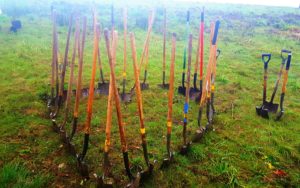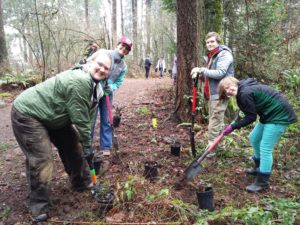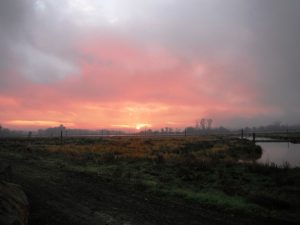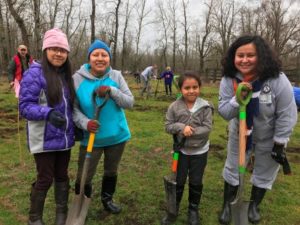Category: Health
Because we love you, events through March are canceled

March 13, 2020
Dear Friends of Trees family,
Because we love you and we want to do our part to diminish the risk of COVID-19 in our community, we are making adjustments to the remainder of our planting season events. Tree planting in the near-term is important to this world; it is not more important than our immediate human health. Currently, all Friends of Trees events in the month of March are canceled. We will let you know about April and beyond when we know.
As we take into account the recommendations of health professionals, we’re asking for your understanding as we reserve the right to continue to change and cancel our events. Please check our online events calendar for the latest information about the status of Friends of Trees events.
The Friends of Trees office is closed to the public through the rest of the month. Staff will work on-site, in the field, or remotely as much as possible, but in the interest of everyone’s health we ask that you not visit our office this month. We’ll keep you posted about April and beyond. If you need to reach us email will be the most effective (it’s not always possible to check our voicemail remotely), you can find a staff directory here; please be patient as it may take a little extra time to get back to you.
Meanwhile, we’re still planting trees. Using a variety of methods and with a variety of partners, as long as it’s OK to do so we will be out there planting trees. It will be hard, and it won’t be nearly as fun as when you’re with us, but, well, it’s what we do and we’ll keep doing it as long as we can.
If you are registered to have a street or yard tree planted at your property, rest assured, your tree/s will be planted. It may not be on the date we planned, nor will it be planted with a team of your neighbors (at least in March), but your tree will be planted. Unfortunately we cannot tell you exactly when your tree will be planted, but don’t be surprised if one day you look out your window and you see a couple of us with shovels. Go ahead and wave. We’ll wave back.
This is all uncharted territory so thank you for your patience and understanding as we navigate this together.
Take care and stay healthy,

Whitney Dorer
Interim Executive Director
P.S. Interested in just exactly what we’ll be up to this month? Check out our social media channels! Visit us on Facebook, Instagram and Twitter.
We need to do something bigger than ourselves.
“We need to do something bigger than ourselves.”
– Mohamed, Friends of Trees volunteer since 2014
Mohamed and his wife Farah, and their children and friends, have planted hundreds of trees with us in memory of their daughter, Ayan. Farah very candidly shares why, “Every tree that we plant I feel like it’s for her. And I think about all of the benefits that all these trees will produce … it keeps on giving. It’s a way of sharing her with the world.”
This beautiful video shares the story about why Mohamed, Farah, and their family plant trees together in honor of Ayan:
“When you are outdoors and in nature you tend to forget whatever problems you may have. When you go into nature with others and look at the beauty, how big things are … it has that healing process.” -Mohamed
The more than 50,000 trees and shrubs we plant every year with so many community volunteers transform neighborhoods and natural areas. Trees clean our air and water, cool the planet, provide habitat—and can help us feel better. There are many examples of how trees improve our health; just the act of planting a tree can be personally transformative; digging in the dirt with the hope and intent of something taking root just feels good.
It’s about trees and it’s about community. When we come together to plant trees we are doing something good, we’re making a difference and we’re making our world a better, more welcoming place.
There is so much we can do that is bigger than ourselves. Donating to Friends of Trees’ programs that plant trees and grow community will help our planet and its inhabitants for generations to come. As Mohamed also shared, “Planting trees really will outlive us. The effort that you put is so small, the benefit is just gigantic.”
Thank you for the gigantic act of supporting trees + community. We look forward to planting trees with you!
Trees & Health Symposium in Gresham on Nov 13

We all know that trees provide benefits to people and the communities they live in.
But do you know how to care for trees to help them thrive, and how you can add to Gresham’s tree canopy at home or in your neighborhood?
The Gresham Trees and Health Symposium will feature a mix of speakers, film, discussion, tree care booths, light refreshments, and a summary of the City’s Green Gresham, Healthy Gresham tree project in Rockwood.
Wednesday, November 13, 2019
6:00 – 8:00 PM, Rockwood Boys & Girls Club
More information and registration information is here, thank you to our co-hosts Multnomah County and City of Gresham!
Welcoming the return of the sun … with trees

“Each Friends of Trees planting event is a series of moments, whether it’s somebody seeing a lizard, or a kid planting their first tree, or people who just happened to be walking by pitching in to help. One of the best moments is at the end of the day when everyone has a big smile on their face because they’ve really accomplished something: they planted trees.” Matt, Friends of Trees volunteer
Did you know that the oldest tree in the world is 5,062 years old? It’s a Pinus longaeva (Great Basin bristlecone pine) and it’s in California.
While we can’t claim with certainty that Friends of Trees just planted the newest tree in the world, it is possible, at least for a moment on any given Saturday, October-April, that we did indeed just plant the newest tree in the world. That’s another Friends of Trees moment: adding a tree–to our region, to our planet. And there are more than 50,000 moments like that every tree planting season.
As we celebrate the Winter Solstice and welcome the return of the sun we’re thinking about the various ways the shortest day of the year is celebrated, especially, of course, the celebrations that include trees. We’ve learned that some Winter Solstice celebrations include specific trees that have specific meanings; for instance, for some observants evergreens symbolize continuity of life, and oak trees symbolize endurance, strength, protection, and good luck.
We love this. Here’s how Friends of Trees interprets these special meanings of evergreens and oaks:
Continuity of life: trees provide oxygen!
Endurance, strength: trees can live to be hundreds, thousands of years old.
Protection: trees clean our air and water and help make us healthy.
Good luck: to me, it’s clear: the more trees we have, the luckier we are.
A recent paper by U.S. Forest Service scientists* reported that metropolitan areas in the U.S. are losing more than 30 million trees each year. This is tragic, but thanks to Friends of Trees’ friends and supporters, we’re not fretting, we’re taking action and tackling this loss, together, one moment at a time, one tree at a time – at more than 50,000 moments, and 50,000 trees, every year. You can help us take positive action through making a donation to Friends of Trees today! Your support helps grow our urban canopy, restore sensitive natural areas, and helps build community through planting trees – together.
Happy Solstice to you and yours, we look forward to longer days, the return of the sun, and more trees – join us!
Friends of Trees’ first bilingual planting ~ El Primer Evento Bilingüe de Plantar árboles de Friends of Trees

[an English translation follows]
Con muchas primeras experiencias para todos, nuestros compañeros del Sandy River Watershed Council nos ayudaron crear un día recordable.
El tercero de Febrero del 2018, 90 voluntarios se reunieron a plantar 1,200 árboles y arbustos en el Sandy River Delta de Troutdale, Oregon. Mientras la acción de plantar árboles es normal para Friends of Trees, este evento fue el primero de muchos momentos especiales: nuestro primer evento bilingüe (español) y el primer evento de plantar en la Delta con solo plantas adaptadas al clima.
Friends of Trees y el Sandy River Watershed Council están dedicados a proviendo eventos cuáles son inclusivos por todos. También estamos comprometidos a compartir los beneficios de árboles con las comunidades diversas con quien trabajamos. Dado nuestra población que sigue creciendo en diversidad, el tiempo para expandir eventos es hoy, no en el futuro. Así que el SRWC nos pidió que trataramos de organizar un evento en Español y Inglés en colaboración. Friends of Trees y el Sandy River Watershed Council tienen empleados que hablan Español-Inglés e igual que voluntarios que ayudan en estos eventos. Y con la fundación de el Wildlife Conservation Society’s Climate Adaptation Fundse pudo realizar la compra de las plantas que usamos para este evento. Como un rompecabezas, todas las piezas ya estaban formando un imagen de éxito.
Pablo Brito, Especialista de Voluntarios, y Carey Aroonsuck, Asistente Administrativo y Voluntario, llevaron la responsabilidad a organizar los logísticos del evento bilingüe por Friends of Trees. Ellos tradujeron materiales como instrucciones como plantar; buscaron Crew Leaders bilingües; compartieron la oportunidad por canales de español e inglés; y trabajaron con Sara Ennis, Community Stewardship Coordinator a Sandy River Watershed Council, hacer un plan para el día de plantar. Pablo también hizo conexiones con un compañero de Latino Network quien quería traer un grupo de estudiantes al evento.
El dia empezó con una introducción en inglés y español dado por Anne Marie Santos, Especialista Mayor de Green Space. Steve Wise, Director ejecutivo de SRWC, dio un mensaje de bienvenido en inglés y español también. ¡Entonces, la diversion empezó! Arboles como la pina ponderosa y arbustos como snowberry fueron plantado por su habilidad a sobrevivir en climás más secos y calurosos.
En el equipo hispanohablante, cual tuvo 20+ voluntarios, la mayoría de los jóvenes plantaron su primer árbol en este día. Había un sentimiento común entre los muchachos quienes estuvieron interesados en regresar al sitio y ver como crecen los árboles que han plantado. Y también, ellos compartieron su interés en ser voluntarios otra vez en el futuro.
“¡Que divertido! No sabía que divertido e interesante este evento seria. Quiero hacerlo otra vez.” -Miguel, edad 14
El evento fue especial para los padres en el grupo también. Hace muchos años que viven aquí en Oregón, pero este día fue la primera vez en mucho tiempo que podría disfrutar y plantar en la naturaleza como lo hicieron en su país natal.
“Hoy fue fantastico—plantar en este lugar tan linda, trabajar con la tierra otra vez, y hacer todo con mis hijos…momentos preciosos.” -Guadalupe, la Madre de Miguel
Nuestro primer evento bilingüe fue hecho solo por las esfuerzas de todos los equipos—Friends of Trees y el Sandy River Watershed Council. Ahora, miramos a las oportunidades que vienen para aplicar las lecciones de este primer evento a eventos futuros de ambos programas—Green Space y Neighborhood Trees.
~
Partner Sandy River Watershed Council helped create a memorable day of firsts
On February 3rd this year 90 volunteers came together to plant 1,200 trees and shrubs in the Sandy River Delta. Yes, this is a regular occurrence for Friends of Trees, but this planting featured some exciting firsts: our first bilingual planting and the first planting at the Delta with only climate adaptive plants.
Friends of Trees and the Sandy River Watershed Council are committed to events that are welcoming for all; we’re also committed to sharing the benefits of trees with diverse communities. Given our region’s diversifying population, the time was right to expand our horizons, so SRWC reached out about a Spanish-English bilingual event. Both Friends of Trees and the Sandy River Watershed Council have bilingual Spanish-English staff and volunteers, and funding from the Wildlife Conservation Society’s Climate Adaptation Fundtook care of the plants, so all of the pieces for this unique event were in place.
Friends of Trees staff member Carey Aroonsuck took the lead in organizing the bilingual planting on the FOT side. Carey worked with fellow staffer Pablo Brito to translate necessary materials; secure bilingual crew leaders; connect with the Latino Network and conduct other culturally-specific outreach about the volunteer opportunity; and coordinate planting day logistics with SRWC staff, who also recruited volunteer planters.
Planting day began with a bilingual introduction from FOT staffer Anne Marie Santos and SRWC Executive Director Steve Wise. Then the volunteers broke into their planting crews and the fun started! We planted trees and shrubs such as Snowberries and Ponderosa Pine, chosen specifically for their ability to survive in a warmer, drier climate.
Of the 20+ volunteers on the Spanish-speaking crew, a majority of the youth planted their first tree that day. Many of the young volunteers shared their excitement about returning to visit the trees they planted, and about volunteering again:
“This is so much fun, I didn’t know this could be so much fun! I want to come back.” -Miguel, age 14
For some of the parents in the group, who grew up in Mexico and have been in the US for many years, this was the first time since they’ve been in this country that they were able to get out into nature and plant something:
“This was just so nice to be able to plant again, and to work with soil again, out in the fresh air. And to plant with my children is extra special.” -Guadalupe, Miguel’s mom
This event was a true team-effort, among Friends of Trees program staff and with project partner Sandy River Watershed Council. We look forward to applying the lessons-learned to provide bilingual events in the future across both our Neighborhood Trees and Green Space programs. Stay tuned!
This is an excerpt from the March 2018 edition of Treemail, read the entire issue here.

